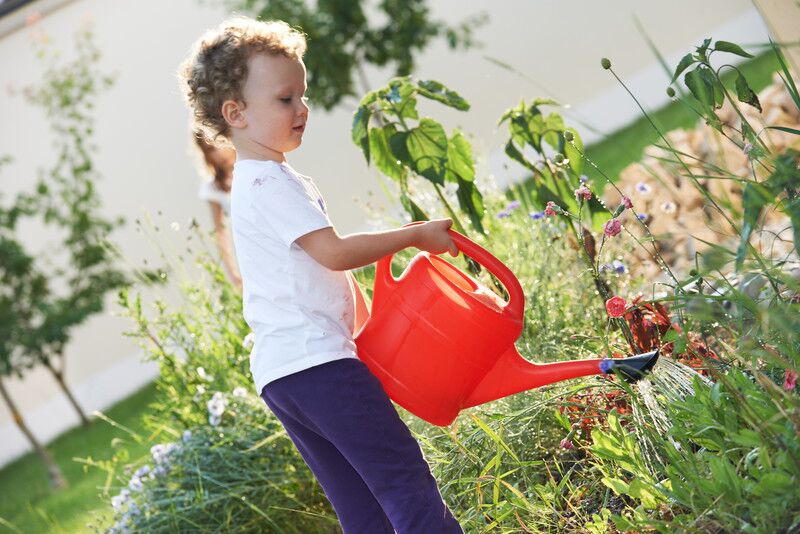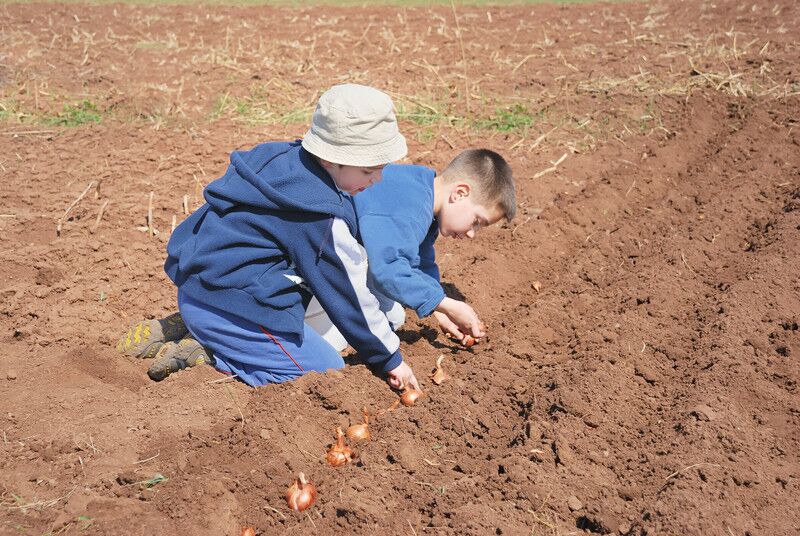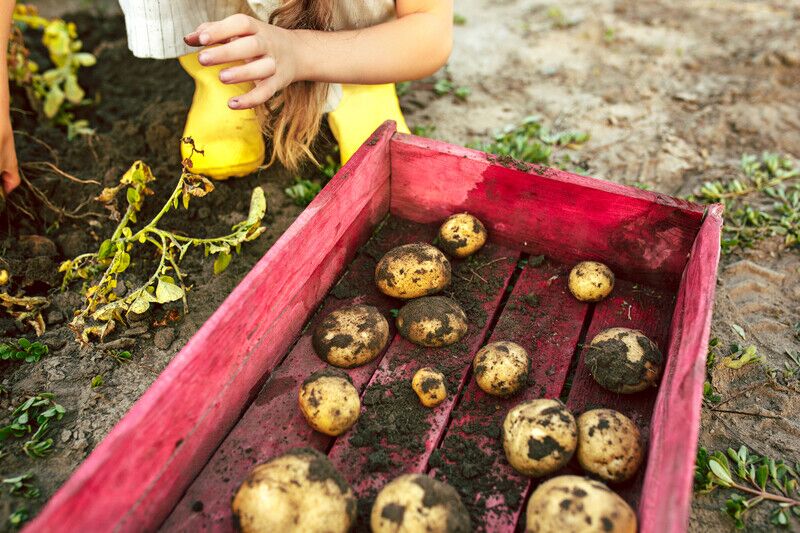Editor’s Note: This article was adapted from the Introduction to The School Garden Curriculum: An Integrated K – 8 Guide for Discovering Science, Ecology, and Whole-Systems Thinking, published by New Society Publishers in 2019.
 In an age when many children are becoming disconnected from nature, farmland is being saturated with chemicals, the global climate is unpredictable and extreme, and wild habitats are being replaced by urban development, our communities need creative and innovative leaders to change our world. We need children to learn and engage in a new land ethic that inspires Care for Self, Care for Others, and Care for the Land; we need new generations of changemakers and environmentally conscious global citizens.
In an age when many children are becoming disconnected from nature, farmland is being saturated with chemicals, the global climate is unpredictable and extreme, and wild habitats are being replaced by urban development, our communities need creative and innovative leaders to change our world. We need children to learn and engage in a new land ethic that inspires Care for Self, Care for Others, and Care for the Land; we need new generations of changemakers and environmentally conscious global citizens.
We accomplish this by encouraging children to engage in ecosystems and by creating spaces for cooperative stewardship and interaction. We provide opportunities to practise building community, creative problem-solving, healthy lifestyles, personal responsibility, craftsmanship, and engagement in nature through science. Gardens are a powerful place to learn these valuable skills and to foster strong environmental and social literacy.
How can children produce food, learn science skills, and develop ecological values at the same time? This may seem to ask a lot from a single garden space. Over years of teaching garden education, I have created a model of what collaboration between permaculture-inspired practices, ecological mindsets, and science-based activities can look like in a school garden. There is an endless collaboration between science and permaculture, in practice and philosophy. Both require a systems-based mindset to guide individual and group work; both utilize observation, data gathering, and analysis to understand how diverse pieces create an interconnected whole. They encourage prioritizing objectivity over subjectivity and using a beginner’s mind to experience wonder, generate questions, and explore ecology and natural systems.
Youth learning gardens are powerful places for children to cultivate the skills and mindset of science and permaculture. They are where children learn to observe and interact and develop positive cooperation skills, inclusivity, and inquiry. When science and permaculture are focused together in one place for children—a youth garden—the ecosystem studies and science skills that they develop and delve into are incredible.
Cultivating a Gardener’s Mind
One valuable and practical aspect of my garden program is the ritualization of certain garden chores. Each season, children of every age group participate in garden activities that help care for and develop the school garden by sowing seeds, mulching, planting starts, and composting. And even though some activities are repeated every year, they do not lose their meaning. Rather, they enhance the children’s gardening knowledge by utilizing new themes for every grade and more complex engagement from different perspectives.
 During visits to other school gardens, I have noticed teachers or coordinators who delegate certain tasks based on age. The job of one lower-grade class will be to plant garlic, but in the next grade the students move on to mulching and never return to nurture and observe their garlic as it grows. While I realize value in having students do age-appropriate activities—there are some things a five-year-old will struggle with—I’ve seen students lose appreciation for a garden activity when they no longer engage with it in following years. Some schools have their students garden for the first few years and then participate in only a couple of gardening projects when they get older. I would challenge these schools to do more.
During visits to other school gardens, I have noticed teachers or coordinators who delegate certain tasks based on age. The job of one lower-grade class will be to plant garlic, but in the next grade the students move on to mulching and never return to nurture and observe their garlic as it grows. While I realize value in having students do age-appropriate activities—there are some things a five-year-old will struggle with—I’ve seen students lose appreciation for a garden activity when they no longer engage with it in following years. Some schools have their students garden for the first few years and then participate in only a couple of gardening projects when they get older. I would challenge these schools to do more.
 Repetition instills more than a “practice makes perfect” model— though the children do improve planting, harvesting, and garden techniques each time they practise them. When children engage in seasonal garden activities every year, they develop valuable intrinsic knowledge of how seasons change, and they participate in the human agricultural tradition which tells them, “Now is the time to save seeds” or “Plant your seeds for summer food.” I want children to watch leaves change colours and get an itchy sense nagging at them, from deep in their bodies and minds, that now is the time to prepare the garden for winter. This is the gift we can pass onto them so that years later, even if they forget many of the techniques of gardening, they are connected to the natural seasons and know intrinsically how to grow a garden.
Repetition instills more than a “practice makes perfect” model— though the children do improve planting, harvesting, and garden techniques each time they practise them. When children engage in seasonal garden activities every year, they develop valuable intrinsic knowledge of how seasons change, and they participate in the human agricultural tradition which tells them, “Now is the time to save seeds” or “Plant your seeds for summer food.” I want children to watch leaves change colours and get an itchy sense nagging at them, from deep in their bodies and minds, that now is the time to prepare the garden for winter. This is the gift we can pass onto them so that years later, even if they forget many of the techniques of gardening, they are connected to the natural seasons and know intrinsically how to grow a garden.
The Garden as an Ecosystem
Practise letting go of any notion of what a garden should look like. What can a children’s garden bloom into? With an open mind, evaluate the intentions of garden spaces and the community members participating in it. What will a children’s garden become when science, observation, wonder, and thoughtfulness are practised? It will be an ecosystem, a science lab, and a place of discovery. Adults can be helpful but also a damaging influence on school or youth gardens. Full of idealistic images and lacking a beginner’s mind, willful adults can salt slugs, build sharp-edged raised beds, spray aphids, remove edible so-called weeds, and expose bare soil to the heat of the summer sun. Their priority is on a product, not a process.
In The Sense of Wonder, Rachel Carson observed, “A child’s world is fresh and new and beautiful, full of wonder and excitement. It is our misfortune that for most of us that clear-eyed vision, that true instinct for what is beautiful and awe-inspiring, is dimmed and even lost before we reach adulthood.” Children are brimming with the capacity for wonder and awe. When student goals are to observe, study patterns and complex relationships, ask questions, conduct experiments, and learn from direct experience, they perceive the garden as an ecosystem and their wonder at the natural world is magnified. Youth gardens should be created from the minds and hands of children, who build up the space and their ownership of it rather than act as occasional visitors who perform stand-alone activities.
Children who work with permaculture, ecology, and science in mind will understand how soil organisms relate to decomposition and plant growth, consumer insects, predators, pollinators, seed sprouting, and so much more. Their knowledge of the garden as an ecosystem will be vast and punctuated by wonder, a willingness to experiment, and a deep appreciation for the value of a whole and complex system. The learning garden will look a little wild, but children will be committed to it, own it, and own their learning.
Children in Charge Everywhere
 When children are allowed to be in charge of a garden, pick up slugs without prejudice, watch how they bite into leaves, and determine their own solutions from an ecological perspective, then they will naturally piece together an understanding of a holistic garden ecosystem. They will also engage in valuable experiences of failure and apply trial and error, inquiry, and direct experience to their learning.
When children are allowed to be in charge of a garden, pick up slugs without prejudice, watch how they bite into leaves, and determine their own solutions from an ecological perspective, then they will naturally piece together an understanding of a holistic garden ecosystem. They will also engage in valuable experiences of failure and apply trial and error, inquiry, and direct experience to their learning.
A method to enhance these opportunities is for an entire school or community to share the garden. This means that children work with the whole garden and overlap their plantings with other groups while interacting in the same spaces. Many schools are in favour of assigning a garden bed for each grade level as a way to delegate work in the garden. While this is successful for some schools, I have found that it pushes too many children into too small of a space, limits their engagement in activity for briefer amounts of time, and inhibits a sense of commitment to the work students perform. Students who plant tomatoes in one bed and then graduate to a new class and garden bed are not encouraged to see the relationships between those tomatoes and the plants or soils they are currently tending.
Classes that plant in containers, window boxes, or inside classrooms have very different space requirements and opportunities for whole-school interaction. But if it is possible to have students return to their past container gardens and interact with them in the following seasons, I would encourage educators to make the time for those opportunities.
Letting children garden and interact with a whole space provides more opportunities for observing the garden’s needs and its changes, while increasing a child’s relationship and connections with the land. The space will change over time, and more opportunities will arise in an organic succession of student learning and natural spaces. When children are in charge, they can creatively challenge and innovate preconceptions of right and wrong and develop new, sustainable value systems in the garden.
Inspiring a Garden Culture
The sustainability of a gardening program is tied to a school-wide commitment to the garden space or gardening initiative. School garden programs struggle if there is only one teacher integrating garden activities in their class. In order to truly offer the students a science-based ecosystem experience that transforms their environmental literacy, let all of the school be involved. The garden then becomes a place where students build knowledge by applying their lessons in a physical way. But how can staff and school boards be motivated to buy in on the garden and commit to a yield? By experiencing the garden not as an additional chore but as the focal point of hands-on and science-based enhancement of the students’ indoor studies, as well as an indispensable part of community culture, seasonal celebrations, and social events.
A school and community garden culture can also be enhanced through continuous use and engagement, such as talking about the garden publicly, reading about gardening themes in class, and studying other subjects in the space. Unstructured sensory exploration is also critical for fostering a culture that celebrates a positive land ethic and a child’s relationship to land. As Rachel Carson suggested in The Sense of Wonder, visceral connection and engagement inspires a desire for knowledge. Facts without emotional and experiential context hold little meaning. Leaving the garden open for student retreat and recovery, feeding families, making friends, magic, and wonder powerfully fosters positive garden culture.
Behaviour expectations are important in setting a standard for community use and respect of the garden. The three expectations that inspired me at the first school garden I built are derived from the Ethical Principles of Permaculture: Care for Self, Care for Others, and Care for the Land (setting limits to consumption and redistributing the surplus). These principles provide my framework for ecological-based garden expectations and student behaviour. I’ve heard it used in other school gardens using different language. The remaining permaculture tenets and ecological ethics fit into these three broad categories, and are stated in words that children can easily aspire to understand and use.
These three ethics support the inclusive ecosystem-perspective of the garden, including the humans in it, and help foster socially and environmentally minded action. They guide children on how to treat each other in and outside of the garden. And they are flexible to children’s growth by providing an empathetic framework for day-to-day activities. The students discuss what Care for Self, Care for Others, and Care for the Land means when exploring the garden or engaging with an activity. This behaviour could look like keeping low voices so as not to scare the living creatures in the garden, walking instead of running, and respecting each other’s personal space. By creating a social contract within the class and making a list of behaviours that the class can refer to, students play their roles as community members, gardeners, and scientists responsibly and respectfully.
Planting Perennially and All-Season
Another perspective that helps garden programs thrive—and limits the stress of summer maintenance—is planting perennials and planting throughout every season. For schools that have summer breaks, garden education really begins in the fall, which is also the end of many annual plant life cycles. The first garden lesson begins in a time of transition. While many other gardens are “being put to bed” to wait for spring planting, fall can be an active season in the youth learning garden.
Permaculture and ecological gardens grow many of the same plants as a more conventional one, but prioritize perennials and all-season, cold-loving plants as well. Throughout the fall, winter, and early spring, a garden can provide taste tests of brassicas, edible “weeds,” root vegetables, and plants grown under student-made cold frames or cloches. As a perennial garden becomes more established, natural succession and changes among plant systems will occur. Fruit trees will grow to provide shade, food, and leaf mulch. The seasonal foods and fruits will change, and new plant species may need to be introduced to thrive in changing environments or niches. Crop extension tools such as cold frames, cloches, frost-cloth, and mini-greenhouses can contribute to all-season food production even more. As more perennial or multi-season plants become established, the amount of labour is often reduced because of the hardiness of these plants. A focus on perennial plants can slowly reduce the stresses of schools over summer garden maintenance.
 Summer Maintenance
Summer Maintenance
After months of intensive gardening and science experiments, the heat of the summer is a school gardener’s version of “winter rest.” Now is the time to rely on all the careful work the school has done in the garden and see how successful it was when the students return in the fall.
In my experience, when the students do return, it is to a lush, jungle garden. Most plants survive, a few do not—but what a great learning opportunity! And every year, the students can come back into the garden to a ready feast. They will spend months munching on tomatoes, beans, edible flowers, cucumbers, rhubarb, and so much more. And because of the vibrant soil health, these plants last far into the fall and provide months of produce for the community to eat.
Share the Surplus
There are opportunities for seasonal taste testing at the end of almost every lesson, and a few harvest celebrations and events are possible. Taste testing is a great way to explore new foods and flavours. The ritual of sharing a small meal after class allows for regular conversations about flavour, preference, recipes, and changing taste buds. Foraging is my preferred method of student taste test experience, though the ability to forage-and-eat in a school garden may depend on regional and district regulations. However, when children forage for their food, then they take ownership of their choices and are more open to new experiences, seasonality, and experimentation.
Honouring the permaculture design principle of Obtaining a Yield should be a priority in every season. Each school has different goals and needs in their garden, so the methods of processing produce will vary. Where student hunger isn’t a concern, I’ve seen some schools donate their harvests to local food banks. I’ve used a school garden as a “free grocery store” for rural families and students who live a distance from a store with fresh produce. Other schools work alongside their food services and nutritionists to incorporate the garden produce into student meals. Find the needs in your school, discuss the dreams and goals of the community around the garden, and acknowledge the reality of accomplishing or building this vision.
Worksheets that accompany the lessons in The School Garden Curriculum can be accessed here: https://s3-us-west-2.amazonaws.com/nsp-blurbs/School-Garden-Curriculum-Appendix-A-Worksheets.pdf
ABOUT THE AUTHOR
Kaci Rae Christopher
Kaci Rae Christopher is an outdoor and garden educator who focuses on life skills training for young adults and children.
This article is from Canadian Teacher Magazine’s Spring 2019 issue.











